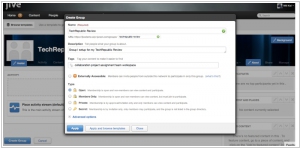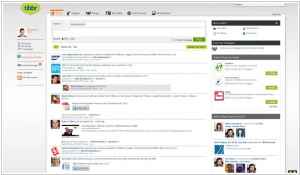Jive vs TIBCO tibbr
March 12, 2025 | Author: Adam Levine
3★
Jive’s enterprise social networking platform allows you to engage employees, customers, and the social web. Increase the efficiency of internal communication, build brand loyalty, and monitor customer chatter and ideas, all from one central location. Say good bye to your intranet, multiple logins for scattered enterprise apps, and being out of the loop; the Jive Engage platform integrates the social networking tools you love and need so you can focus on what matters.
1★
The enterprise collaboration platform with 360-degree view of people, discussions, tasks, and content via mobile, web and apps.
Jive and TIBCO tibbr are both enterprise social networking platforms, which is a fancy way of saying they exist to stop people from emailing the same document back and forth until the end of time. They let employees share information, collaborate and generally pretend they are engaging with their work in a meaningful way while actually just clicking around until lunchtime. Both come with integrations for tools people already use, mobile access for those who wish to work from anywhere (but mostly just check notifications from the couch) and security features to ensure only the right people see the wrong things.
Jive has been around since 2001, which in tech years makes it practically a fossil, though a very polished and well-funded one. It’s all about deep intranet magic, where content gets recommended to you by algorithms that pretend to know what you need before you do. Big companies love it because it organizes vast amounts of corporate wisdom—by which we mean thousands of PowerPoint slides that nobody ever reads. It was acquired in 2017 by Aurea, ensuring that its fate, like all software, remains in the hands of a company that will probably claim to have "exciting plans" while quietly cutting features.
Tibbr, on the other hand, arrived in 2010, a fresh-faced alternative that decided the real problem with workplace chatter was that people weren’t talking in the right topics. So, it structured everything into topic-based conversations, making it easier to ignore entire subjects rather than just individual emails. It’s great for companies that need to mix social networking with business processes, particularly in industries where rules and regulations dictate that people should talk about things in a very specific way before ignoring them completely. While it never quite set the world on fire, it found a niche among businesses that like their collaboration tools to come with a side of structured workflow bureaucracy.
See also: Top 10 Intranet Portals
Jive has been around since 2001, which in tech years makes it practically a fossil, though a very polished and well-funded one. It’s all about deep intranet magic, where content gets recommended to you by algorithms that pretend to know what you need before you do. Big companies love it because it organizes vast amounts of corporate wisdom—by which we mean thousands of PowerPoint slides that nobody ever reads. It was acquired in 2017 by Aurea, ensuring that its fate, like all software, remains in the hands of a company that will probably claim to have "exciting plans" while quietly cutting features.
Tibbr, on the other hand, arrived in 2010, a fresh-faced alternative that decided the real problem with workplace chatter was that people weren’t talking in the right topics. So, it structured everything into topic-based conversations, making it easier to ignore entire subjects rather than just individual emails. It’s great for companies that need to mix social networking with business processes, particularly in industries where rules and regulations dictate that people should talk about things in a very specific way before ignoring them completely. While it never quite set the world on fire, it found a niche among businesses that like their collaboration tools to come with a side of structured workflow bureaucracy.
See also: Top 10 Intranet Portals




